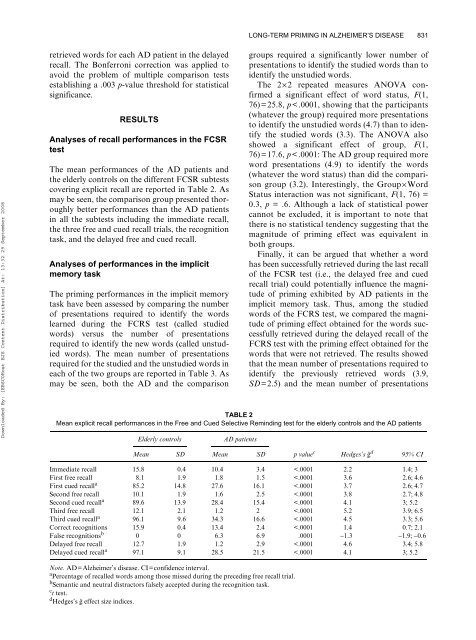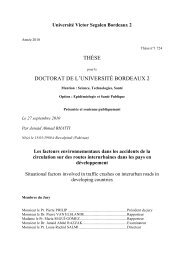Télécharger le texte intégral
Télécharger le texte intégral
Télécharger le texte intégral
You also want an ePaper? Increase the reach of your titles
YUMPU automatically turns print PDFs into web optimized ePapers that Google loves.
LONG-TERM PRIMING IN ALZHEIMER’S DISEASE 831Downloaded By: [EBSCOHost EJS Content Distribution] At: 13:32 29 September 2008retrieved words for each AD patient in the delayedrecall. The Bonferroni correction was applied toavoid the prob<strong>le</strong>m of multip<strong>le</strong> comparison testsestablishing a .003 p-value threshold for statisticalsignificance.RESULTSAnalyses of recall performances in the FCSRtestThe mean performances of the AD patients andthe elderly controls on the different FCSR subtestscovering explicit recall are reported in Tab<strong>le</strong> 2. Asmay be seen, the comparison group presented thoroughlybetter performances than the AD patientsin all the subtests including the immediate recall,the three free and cued recall trials, the recognitiontask, and the delayed free and cued recall.Analyses of performances in the implicitmemory taskThe priming performances in the implicit memorytask have been assessed by comparing the numberof presentations required to identify the words<strong>le</strong>arned during the FCRS test (cal<strong>le</strong>d studiedwords) versus the number of presentationsrequired to identify the new words (cal<strong>le</strong>d unstudiedwords). The mean number of presentationsrequired for the studied and the unstudied words ineach of the two groups are reported in Tab<strong>le</strong> 3. Asmay be seen, both the AD and the comparisongroups required a significantly lower number ofpresentations to identify the studied words than toidentify the unstudied words.The 2×2 repeated measures ANOVA confirmeda significant effect of word status, F(1,76)=25.8, p
















